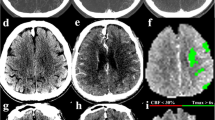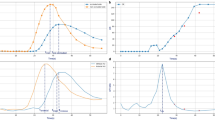Abstract
Objectives
To compare collateral status on single-phase CT angiography (sCTA) and multiphase CT angiography (mCTA) and their ability to predict a target mismatch on CT perfusion (CTP) and clinical outcome in patients with acute ischemic stroke (AIS).
Methods
Seventy-three AIS patients with stroke onset between 5 and 15 h or with unclear onset time and occlusions in the M1/M2 segment of the middle cerebral artery and/or intracranial internal carotid artery underwent head non-contrast CT and CTP. Simulated sCTA and mCTA were reconstructed from CTP data and were compared for collaterals assessment. The ability to predict target mismatch on CTP (an ischemic core < 70 ml, a mismatch ratio ≥ 1.8, and an absolute difference ≥ 15 ml) and 90-day modified Rankin Scale (mRS) score of 0–2 was compared between sCTA and mCTA by using receiver operating curve analysis.
Results
sCTA underestimated the collateral status when compared with mCTA (p < 0.01). The ability of mCTA to predict target mismatch (AUC = 0.902, 95% confidence interval [CI] 0.809, 0.959) and clinical outcome (AUC = 0.771; 95% CI, 0.655, 0.864) was better than that of sCTA (p < 0.05 overall). A mCTA collateral score of > 3 best identified the target mismatch (sensitivity, 78.4%; specificity, 90.9%) and predicted 90-day mRS score of 0–2 (sensitivity, 84.8%; specificity, 69.4%).
Conclusions
The collaterals were better estimated by mCTA compared with sCTA. A mCTA collateral score of > 3 optimized the prediction of a target mismatch on CTP and a good clinical outcome in patients with AIS.
Key Points
• Collateral circulation is a key determinant of ischemic core and penumbra. Better collaterals are associated with smaller ischemic core volumes and larger mismatch ratios on CT perfusion.
• The collaterals can be better estimated by multiphase CTA compared with single-phase CTA.
• A collateral score of > 3 on multiphase CTA best identifies patients with target mismatch on CT perfusion and predicts 90-day mRS score of 0–2.



Similar content being viewed by others
Abbreviations
- AIF:
-
Arterial input function
- AIS:
-
Acute ischemic stroke
- AUC:
-
Area under the ROC curve
- CBF:
-
Cerebral blood flow
- CTA:
-
CT angiography
- CTP:
-
CT perfusion
- ICA:
-
Internal carotid artery
- IMS:
-
Interventional Management of Stroke
- MCA:
-
Middle cerebral artery (MCA)
- mCTA:
-
Multiphase CT angiography
- NCCT:
-
Non-contrast CT
- NIHSS:
-
National Institute of Health Stroke Scale
- RCTs:
-
Randomized controlled trials
- ROC:
-
Receiver operating characteristic
- sCTA:
-
Single-phase CT angiography
- Tmax :
-
Time to maximum
- VIF:
-
Venous input function
- VPCT:
-
Volume perfusion CT
References
Berkhemer OA, Fransen PS, Beumer D et al (2015) A randomized trial of intraarterial treatment for acute ischemic stroke. N Engl J Med 372:11–20
Campbell BC, Mitchell PJ, Kleinig TJ et al (2015) Endovascular therapy for ischemic stroke with perfusion-imaging selection. N Engl J Med 372:1009–1018
Goyal M, Demchuk AM, Menon BK et al (2015) Randomized assessment of rapid endovascular treatment of ischemic stroke. N Engl J Med 372:1019–1030
Jovin TG, Chamorro A, Cobo E et al (2015) Thrombectomy within 8 hours after symptom onset in ischemic stroke. N Engl J Med 372:2296–2306
Saver JL, Goyal M, Bonafe A et al (2015) Stent-retriever thrombectomy after intravenous t-PA vs. t-PA alone in stroke. N Engl J Med 372:2285–2295
Goyal M, Menon BK, Derdeyn CP (2013) Perfusion imaging in acute ischemic stroke: let us improve the science before changing clinical practice. Radiology 266:16–21
Kudo K, Sasaki M, Yamada K et al (2010) Differences in CT perfusion maps generated by different commercial software: quantitative analysis by using identical source data of acute stroke patients. Radiology 254:200–209
Bivard A, Levi C, Spratt N, Parsons M (2013) Perfusion CT in acute stroke: a comprehensive analysis of infarct and penumbra. Radiology 267:543–550
Liebeskind DS (2003) Collateral circulation. Stroke 34:2279–2284
Menon BK, Qazi E, Nambiar V et al (2015) Differential effect of baseline computed tomographic angiography collaterals on clinical outcome in patients enrolled in the Interventional Management of Stroke III trial. Stroke 46:1239–1244
Berkhemer OA, Jansen IG, Beumer D et al (2016) Collateral status on baseline computed tomographic angiography and intra-arterial treatment effect in patients with proximal anterior circulation stroke. Stroke 47:768–776
Dehkharghani S, Bammer R, Straka M et al (2016) Performance of CT ASPECTS and collateral score in risk stratification: can target perfusion profiles be predicted without perfusion imaging? AJNR Am J Neuroradiol 37:1399–1404
Vagal A, Menon BK, Foster LD et al (2016) Association between CT angiogram collaterals and CT perfusion in the Interventional Management of Stroke III trial. Stroke 47:535–538
Menon BK, d'Esterre CD, Qazi EM et al (2015) Multiphase CT angiography: a new tool for the imaging triage of patients with acute ischemic stroke. Radiology 275:510–520
Frolich AM, Psychogios MN, Klotz E, Schramm R, Knauth M, Schramm P (2012) Angiographic reconstructions from whole-brain perfusion CT for the detection of large vessel occlusion in acute stroke. Stroke 43:97–102
Campbell BC, Christensen S, Levi CR et al (2011) Cerebral blood flow is the optimal CT perfusion parameter for assessing infarct core. Stroke 42:3435–3440
Calamante F, Christensen S, Desmond PM, Ostergaard L, Davis SM, Connelly A (2010) The physiological significance of the time-to-maximum (Tmax) parameter in perfusion MRI. Stroke 41:1169–1174
Olivot JM, Mlynash M, Thijs VN et al (2009) Optimal Tmax threshold for predicting penumbral tissue in acute stroke. Stroke 40:469–475
Albers GW, Marks MP, Kemp S et al (2018) Thrombectomy for stroke at 6 to 16 hours with selection by perfusion imaging. N Engl J Med 378:708–718
Saver JL, Jahan R, Levy EI et al (2012) Solitaire flow restoration device versus the merci retriever in patients with acute ischaemic stroke (SWIFT): a randomised, parallel-group, non-inferiority trial. Lancet 380:1241–1249
Boers AM, Jansen IG, Berkhemer OA et al (2017) Collateral status and tissue outcome after intra-arterial therapy for patients with acute ischemic stroke. J Cereb Blood Flow Metab 37:3589–3598
Kim EY, Shin DH, Noh Y, Goh BH, Lee YB (2016) Comparison of imaging selection criteria for intra-arterial thrombectomy in acute ischemic stroke with advanced CT. Eur Radiol 26:2974–2981
Powers WJ, Rabinstein AA, Ackerson T et al (2018) 2018 guidelines for the early management of patients with acute ischemic stroke: a guideline for healthcare professionals from the American Heart Association/American Stroke Association. Stroke 49:e46–e110
Yang CY, Chen YF, Lee CW et al (2008) Multiphase CT angiography versus single-phase CT angiography: comparison of image quality and radiation dose. AJNR Am J Neuroradiol 29:1288–1295
Acknowledgements
We sincerely thank Mrs. Min-lin Zhou from the National Clinical Research Center of Kidney Diseases, Jinling Hospital, for her reviewing of all the statistics. We also thank Dr. Kai Qiu and Dr. Wei Wang for their kind help in collecting the clinical information.
Funding
The authors state that this work has not received any funding.
Author information
Authors and Affiliations
Corresponding author
Ethics declarations
Guarantor
The scientific guarantor of this publication is Dr. Hai-bin Shi.
Email address: shihb@njmu.edu.cn.
Conflict of interest
The authors of this manuscript declare no relationships with any companies whose products or services may be related to the subject matter of the article.
Statistics and biometry
Mrs. Min-lin Zhou from national clinical research center of kidney diseases, Jinling Hospital, kindly provided statistical advice for this manuscript.
Informed consent
Written informed consent was waived by the Institutional Review Board.
Ethical approval
Institutional Review Board approval was obtained.
Methodology
• Retrospective
• Case-control study
• Performed at one institution
Additional information
Publisher’s note
Springer Nature remains neutral with regard to jurisdictional claims in published maps and institutional affiliations.
Rights and permissions
About this article
Cite this article
Lu, Ss., Zhang, X., Xu, Xq. et al. Comparison of CT angiography collaterals for predicting target perfusion profile and clinical outcome in patients with acute ischemic stroke. Eur Radiol 29, 4922–4929 (2019). https://doi.org/10.1007/s00330-019-06027-9
Received:
Revised:
Accepted:
Published:
Issue Date:
DOI: https://doi.org/10.1007/s00330-019-06027-9




